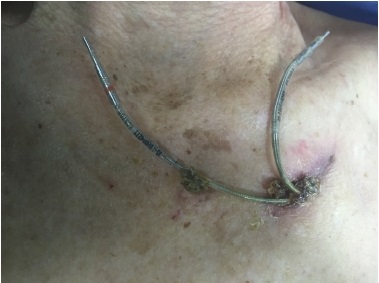Kosin Med J.
2018 Dec;33(3):396-401. 10.7180/kmj.2018.33.3.396.
Successful Removal of 15-year-old Pacemaker Leads by Weight and pulley method
- Affiliations
-
- 1Department of Internal Medicine, Inje University Busan Paik Hospital, Busan, Korea. isobgary@naver.com
- KMID: 2442551
- DOI: http://doi.org/10.7180/kmj.2018.33.3.396
Abstract
- Extraction of old pacemaker leads remains a complex procedure owing to fibrotic encapsulation and lead adhesions. We report a case of extraction of 15-year-old pacemaker leads by weight and pulley method. A 81-year-old man presented with exposed pacemaker leads out of body with purulent discharge from a pacemaker insertion site. He inserted DDD (dual chamber pacing, dual chamber sensing dual function) pacemaker implantation 15 years ago for SSS. Previously pacemaker battery was removed 3 years ago due to recurrent infection of pacemaker scar site. We extracted the pacemaker leads by weight and pulley method successfully without any complications.
Keyword
MeSH Terms
Figure
Reference
-
1. Greenspon AJ, Patel JD, Lau E, et al. 16-year trends in the infection burden for pacemakers and implantable cardioverter-defibrillators in the United States 1993 to 2008. J Am Coll Cardiol. 2011; 58(10):1001–1006.
Article2. de Bie MK, Fouad DA, Borleffs CJ, et al. Trans-venous lead removal without the use of extraction sheaths, results of >250 removal procedures. Europace. 2012; 14(1):112–116.
Article3. Love CJ, Wilkoff BL, Byrd CL, et al. Recommendations for extraction of chronically implanted transvenous pacing and defibrillator leads: indications, facilities, training. North American Society of Pacing and Electrophysiology Lead Extraction Conference Faculty. Pacing Clin Electrophysiol. 2000; 23(4 Pt 1):544–551.4. Kennergren C, Bjurman C, Wiklund R, Gäbel J. A single-centre experience of over one thousand lead extractions. Europace. 2009; 11(5):612–617.
Article5. Koulouris S, Metaxa S. Intravascular Lead Extractions: Tips and Tricks.6. Neuzil P, Taborsky M, Rezek Z, et al. Pacemaker and ICD lead extraction with electrosurgical dissection sheaths and standard transvenous extraction systems: results of randomized trial. Europace. 2007; 9:98–104.
Article7. Carsten L, Herribert P, Christian G, et al. Forces Applied during Transvenous Implantable Cardioverter Defibrillator Lead Removal. Biomed Res Int. 2014; 2014:183483.8. Voigt A, Shalaby A, Saba S. Continued rise in rates of cardiovascular implantable electronic devisce infections in the United States : temporal trends and causative insights. Pacing Clin Electrophysiol. 2010; 33:414–419.
Article
- Full Text Links
- Actions
-
Cited
- CITED
-
- Close
- Share
- Similar articles
-
- Repositioning of Pacemaker Generator due to Therapeutic Radiation: A Tunneling Method
- Trigger Finger of a Distal A2 Pulley
- Permanent Pacemaker Lead Induced Severe Tricuspid Regurgitation in Patient Undergoing Multiple Valve Surgery
- Extraction of an Infected Permanent Pacemaker Lead UsingCardiopulmonary Bypass: 2 case reports
- A Case of Pacemaker Implantation after Balloon Venoplasty on Innominate Vein Stenosis






